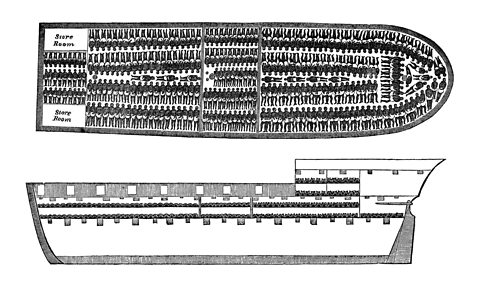Why was sugar grown on Caribbean plantations?
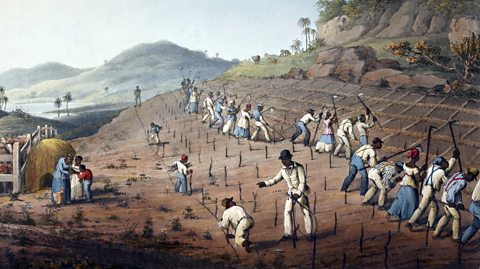 Image source, ALAMY
Image source, ALAMYQuick version
Caribbean plantations were responsible for most of the sugar consumed in Europe.
- high demand for sugar meant large profits
- the Caribbean climate suited growing sugar cane
- enslaved labour provided a cheap workforce
On plantations, raw sugar syrup was turned into high value goods such as:
- sugar
- rum.
These goods were exported back to Europe as part of the triangular trade.
Learn in more depth
Why did sugar become the main crop in the Caribbean?
In Europe, sugar was a luxury for only the very rich until the 1500s. Portuguese colonies in Brazil began growing sugar cane using enslaved Africans for labour.
In the 17th century, sugar cane was brought to British West Indies from Brazil.
At that time most local farmers were growing cotton and tobacco. However, strong competition from the North American colonies meant that prices in these crops were falling.
The owners of the large Caribbean plantations decided to switch to growing sugar cane.
The sugar cane plant was the main crop produced on the numerous plantations throughout the Caribbean during the 18th and 19th centuries. These plantations produced 80ÔÇô90 per cent of the sugar consumed in Western Europe.
Almost every island was covered with sugar plantations and mills for refining the cane for its sweet properties. Until the abolition of slavery, the main source of labour was enslaved African people.
Why did sugar grow in popularity?
Between 1700 and 1790 the trade in sugar increased dramatically due to the increasing popularity of sugar to sweeten luxury drinks such as tea and coffee, and to make sweetened foods including jams, sweets and baking.
In 1700, Britain's sugar consumption was 4 pounds weight per person (around 1.8 kg), a century later that had risen to 18 pounds per person (18.2 kg).
The increased availability and popularity of sugar was due to two factors:
- a gradual increase in the standard of living (whereas before only the very rich could afford such luxuries as sugar)
- the establishment of more New World colonies which were ideally suited to the growing of luxury crops such as sugar.
Although sugar was the most important crop in the Caribbean, other crops such as coffee, indigo and rice were also grown.
Why was sugar grown on plantations?
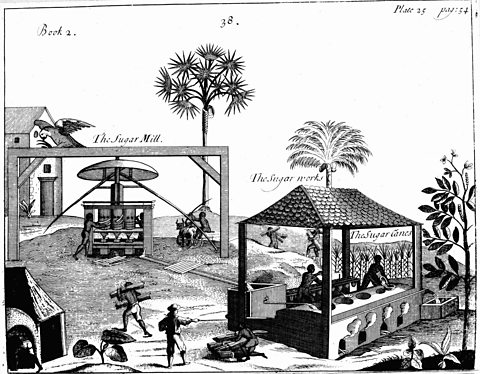 Image source, ALAMY
Image source, ALAMYBetween 1766 and 1791, the British West Indies produced over a million tons of sugar.
The most efficient method of growing the large amounts of sugar cane needed to meet demand was on large plantations with many workers.
Sugar production was labour intensive. Because of the lack of labour in the Caribbean, vast numbers of African people were forcibly transported to work on the sugar plantations throughout the 18th century.
Enslaved labour made harvesting the crop affordable and profitable.
In 1746, economist Malachi Postlethwaite wrote that without enslaved African people, "ÔÇŽwe can have no sugar, tobacco, rum etc. Consequently the public revenue, arising from the importation of plantation produce, will be wiped out. And hundreds of thousands of Britons making goods for the triangular trade will lose their jobs and go a begging".
Many agreed with him, believing that the slavery-based plantation system was vital to British wealth, industry and jobs.
 Image source, ALAMY
Image source, ALAMYHow was sugar produced on plantations?
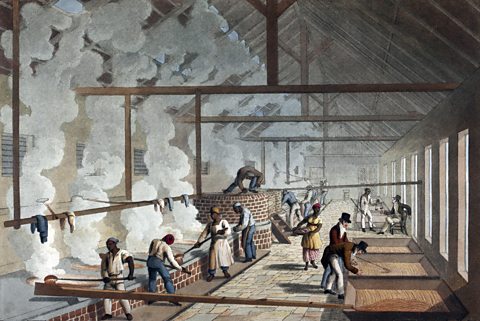 Image source, ALAMY
Image source, ALAMYSugar was produced in the following way:
- ground had to be dug, hoed, weeded, planted and then fertilised with manure
- at harvest time, sugar cane was cut with machetes and loaded onto carts
- harvested cane was taken to the sugar mill where it was crushed and boiled to extract a brown, sticky juice
- sugar juice was left in barrels until a brown syrup called molasses could be drawn off
- the clearer liquid left behind crystallised into sugar, which would then be packed into barrels and shipped to Europe
- the molasses was used to make another of the Caribbean exports ÔÇô rum
 Image source, ALAMY
Image source, ALAMYWhat was it like to work on a sugar plantation?
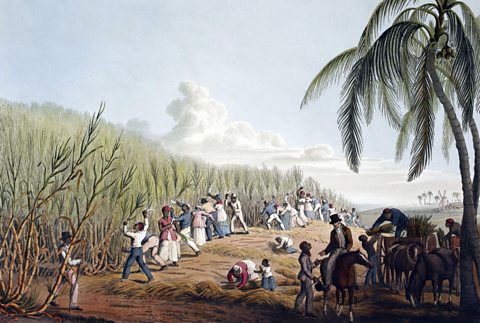 Image source, ALAMY
Image source, ALAMYGrowing sugar was hard, labour-intensive work.
Work gangs consisting of men, women and children worked under white overseers. Enslaved people worked from dawn until dusk. They were whipped for not working hard enough.
Operating the machinery in the sugar mill was very dangerous. People working there could be maimed or even killed. The sugar boiling houses were unbearably hot and difficult to work in during the summer.
At harvest time it was common for enslaved people to work 18-hour days, while some people were forced to work for as long as 48 hours without a break.
Life on the plantations was extremely hard. A third of enslaved Africans died within three years of arriving in the Caribbean. This created a constant demand for new enslaved people to replace them.
 Image source, ALAMY
Image source, ALAMYIndustrial development in sugar production
There was a need for industrial development in sugar production because the low level of technology made sugar production difficult and labour intensive. The demand for sugar was also rising, particularly in Britain.
Plantation owners looked for ways to increase their production:
- harvests were increased by using an irrigation system to water crops
- reservoirs, dams, aqueducts, and canals were built to improve water supply
- more manure was used to fertilise crops.
- more advanced mills with better equipment were developed
- better types of sugar cane that produced more sugar were developed
From the late 18th century, the production of sugar became increasingly mechanised. In 1768, a steam engine was first used to power a sugar mill in Jamaica.
Exporting Caribbean sugar
By 1750, sugar had surpassed grain as the most valuable commodity in European trade ÔÇô it made up one fifth of all European imports.
Taking advantage of this growing demand for sugar, the Caribbean islands set about increasing production. In Barbados, sugar amounted to 93 per cent of the island's exports.
Sugar exports from the Caribbean were a major part of the cargo carried in the third and final stage of the Triangular Trade ÔÇô the 91╚╚▒Č Run.
Slave ships completing the ÔÇśMiddle PassageÔÇÖ from Africa, unloaded and sold their cargo of enslaved people, before being loaded with sugar and rum to sell in Britain.
The main destination ports for ships loaded with sugar were London, Bristol, and Liverpool.
In 1785, 22,811 barrels of sugar were imported through Bristol.
Test what you have learned
Quiz
Recap what you have learned
In this guide we have covered:
- The Caribbean provided the majority of Europe's sugar.
- High demand for sugar meant large profits
- Producing sugar was labour-intensive
- Enslaved Africans provided a cheap labour force for plantations
Raw sugar liquid was processed in mills to produce high value goods such as refined sugar and rum. These goods were shipped back to Europe to be sold.
British ports heavily involved in the sugar trade included:
- London
- Bristol
- Liverpool
More on Trade in enslaved African people
Find out more by working through a topic
- count10 of 10

- count1 of 10
